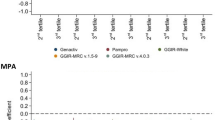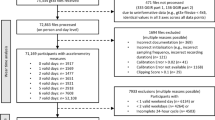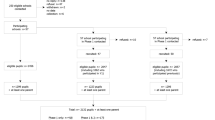Abstract
Objectives:
Focused on the accelerometer-determined physical activity and sedentary time metrics in 9–11-year-old children, we sought to determine the following: (i) number of days that are necessary to achieve reliable estimates (G⩾0.8); (ii) proportion of variance attributed to different facets (participants and days) of reliability estimates; and (iii) actual reliability of data as collected in The International Study of Childhood Obesity, Lifestyle and Environment (ISCOLE).
Methods:
The analytical sample consisted of 6025 children (55% girls) from sites in 12 countries. Physical activity and sedentary time metrics measures were assessed for up to 7 consecutive days for 24 h per day with a waist-worn ActiGraph GT3X+. Generalizability theory using R software was used to investigate the objectives i and ii. Intra-class correlation coefficients (ICC) were computed using SAS PROC GLM to inform objective iii.
Results:
The estimated minimum number of days required to achieve a reliability estimate of G⩾0.8 ranged from 5 to 9 for boys and 3 to 11 for girls for light physical activity (LPA); 5 to 9 and 3 to 10, for moderate-to-vigorous physical activity (MVPA); 5 to 10 and 4 to 10 for total activity counts; and 7 to 11 and 6 to 11 for sedentary time, respectively. For all variables investigated, the ‘participant’ facet accounted for 30–50% of the variability, whereas the ‘days’ facet accounted for ⩽5%, and the interaction (P × D) accounted for 50–70% of the variability. The actual reliability for boys in ISCOLE ranged from ICCs of 0.78 to 0.86, 0.73 to 0.85 and 0.72 to 0.86 for LPA, MVPA and total activity counts, respectively, and 0.67 to 0.79 for sedentary time. The corresponding values for girls were 0.80–0.88, 0.70–0.89, 0.74–0.86 and 0.64–0.80.
Conclusions:
It was rare that only 4 days from all participants would be enough to achieve desirable reliability estimates. However, asking participants to wear the device for 7 days and requiring ⩾4 days of data to include the participant in the analysis might be an appropriate approach to achieve reliable estimates for most accelerometer-derived metrics.
This is a preview of subscription content, access via your institution
Access options
Subscribe to this journal
We are sorry, but there is no personal subscription option available for your country.
Buy this article
- Purchase on Springer Link
- Instant access to full article PDF
Prices may be subject to local taxes which are calculated during checkout




Similar content being viewed by others
References
Allen MJ, Yen WM . Introduction to Measurement Theory. Waveland Press: Long Groove, IL, USA, 2002.
Atkin AJ, Gorely T, Clemes SA, Yates T, Edwardson C, Brage S et al. Methods of measurement in epidemiology: sedentary behaviour. Int J Epidemiol 2012; 41: 1460–1471.
Pedisic Z, Bauman A . Accelerometer-based measures in physical activity surveillance: current practices and issues. Br J Sports Med 2015; 49: 219–223.
Welk GJ, Schaben JA, Morrow JR Jr . Reliability of accelerometry-based activity monitors: a generalizability study. Med Sci Sports Exerc 2004; 36: 1637–1645.
McClain JJ, Sisson SB, Tudor-Locke C . Actigraph accelerometer interinstrument reliability during free-living in adults. Med Sci Sports Exerc 2007; 39: 1509–1514.
Esliger DW, Tremblay MS . Technical reliability assessment of three accelerometer models in a mechanical setup. Med Sci Sports Exerc 2006; 38: 2173–2181.
Esliger DW, Rowlands AV, Hurst TL, Catt M, Murray P, Eston RG . Validation of the GENEA Accelerometer. Med Sci Sports Exerc 2011; 43: 1085–1093.
Silva P, Mota J, Esliger D, Welk G . Technical reliability assessment of the actigraph GT1M accelerometer. Meas Phys Educ Exerc Sci 2010; 14: 79–91.
Ried-Larsen M, Brond J, Brage S, Hansen B, Grydeland M, Andersen L et al. Mechanical and free living comparisons of four generations of the actigraph activity monitor. Int J Behav Nutr Phys Act 2012; 9: 113.
Kang M, Bjornson K, Barreira TV, Ragan BG, Song K . The minimum number of days required to establish reliable physical activity estimates in children aged 2-15 years. Physiol Meas 2014; 35: 2229–2237.
Kang M, Bassett DR, Barreira TV, Tudor-Locke C, Ainsworth B, Reis JP et al. How many days are enough? A study of 365 days of pedometer monitoring. Res Q Exerc Sport 2009; 80: 445–453.
Baranowski T, Masse LC, Ragan B, Welk G . How many days was that? We’re still not sure, but we’re asking the question better!. Med Sci Sports Exerc 2008; 40: S544–S549.
Hinkley T, O’Connell E, Okely AD, Crawford D, Hesketh K, Salmon J . Assessing volume of accelerometry data for reliability in preschool children. Med Sci Sports Exerc 2012; 44: 2436–2441.
Deforche B, De Bourdeaudhuij I, D’Hondt E, Cardon G . Objectively measured physical activity, physical activity related personality and body mass index in 6- to 10-yr-old children: a cross-sectional study. Int J Behav Nutr Phys Act 2009; 6: 25.
Mattocks C, Ness A, Leary S, Tilling K, Blair SN, Shield J et al. Use of accelerometers in a large field-based study of children: protocols, design issues, and effects on precision. J Phys Act Health 2008; 5 (Suppl 1): S98–S111.
Taylor RW, Murdoch L, Carter P, Gerrard DF, Williams SM, Taylor BJ . Longitudinal study of physical activity and inactivity in preschoolers: the FLAME study. Med Sci Sports Exerc 2009; 41: 96–102.
Katzmarzyk PT, Barreira TV, Broyles ST, Champagne CM, Chaput J-P, Fogelholm M et al. The International Study of Childhood Obesity, Lifestyle and the Environment (ISCOLE): design and methods. BMC Public Health 2013; 13: 900.
Wickel EE, Welk GJ . Applying generalizability theory to estimate habitual activity levels. Med Sci Sports Exerc 2010; 42: 1528–1534.
Trost SG, Pate RR, Freedson PS, Sallis JF, Taylor WC . Using objective physical activity measures with youth: how many days of monitoring are needed? Med Sci Sports Exerc 2000; 32: 426–431.
Wickel EE . Reporting the reliability of accelerometer data with and without missing values. PLoS One 2014; 9: e114402.
Basterfield L, Adamson AJ, Pearce MS, Reilly JJ . Stability of habitual physical activity and sedentary behavior monitoring by accelerometry in 6- to 8-year-olds. J Phys Act Health 2011; 8: 543–547.
Tudor-Locke C, Barreira TV, Schuna JM Jr, Mire EF, Chaput JP, Fogelholm M et al. Improving wear time compliance with a 24-hour waist-worn accelerometer protocol in the International Study of Childhood Obesity, Lifestyle and the Environment (ISCOLE). Int J Behav Nutr Phys Act 2015; 12: 172.
Tudor-Locke C, Barreira TV, Schuna Jr JM, Mire EF, Katzmarzyk PT . Fully automated waist-worn accelerometer algorithm for detecting children’s sleep-period time separate from 24-h physical activity or sedentary behaviors. Appl Physiol Nutr Metab 2014; 39: 53–57.
Barreira TV, Schuna Jr JM, Mire EF, Katzmarzyk PT, Chaput JP, Leduc G et al. Identifying children’s nocturnal sleep using 24-h waist accelerometry. Med Sci Sports 2015; 47: 937–943.
Mark AE, Janssen I . Dose-response relation between physical activity and blood pressure in youth. Med Sci Sports Exerc 2008; 40: 1007–1012.
Evenson KR, Catellier DJ, Gill K, Ondrak KS, McMurray RG . Calibration of two objective measures of physical activity for children. J Sports Sci 2008; 26: 1557–1565.
Bates D, Maechler M, Bolker B, Walker S . lme4: Linear mixed-effects models using Eigen and S4, 2014. Available at http://CRAN.R-project.org/package=lme4 (accessed on 1 June 2015).
Shrout PE, Fleiss JL . Intraclass correlations: uses in assessing rater reliability. Psychol Bull 1979; 86: 420–428.
Davies G, Reilly JJ, McGowan AJ, Dall PM, Granat MH, Paton JY . Validity, practical utility, and reliability of the activPAL in preschool children. Med Sci Sports Exerc 2012; 44: 761–768.
Hinckson EA, Hopkins WG, Aminian S, Ross K . Week-to-week differences of children’s habitual activity and postural allocation as measured by the ActivPAL monitor. Gait Posture 2013; 38: 663–667.
Hart TL, Ainsworth BE, Tudor-Locke C . Objective and subjective measures of sedentary behavior and physical activity. Med Sci Sports Exerc 2010; 43: 449–456.
Kozey-Keadle S, Libertine A, Lyden K, Staudenmayer J, Freedson PS . Validation of wearable monitors for assessing sedentary behavior. Med Sci Sports Exerc 2011; 43: 1561–1567.
Trost SG, Loprinzi PD, Moore R, Pfeiffer KA . Comparison of accelerometer cut points for predicting activity intensity in youth. Med Sci Sports Exerc 2011; 43: 1360–1368.
Tudor-Locke C, Camhi SM, Troiano RP . A catalog of rules, variables, and definitions applied to accelerometer data in the National Health and Nutrition Examination Survey, 2003-2006. Prev Chronic Dis 2012; 9: E113.
Acknowledgements
We thank the ISCOLE External Advisory Board and the ISCOLE participants and their families who made this study possible. A membership list of the ISCOLE Research Group and External Advisory Board is included in Katzmarzyk et al. (this issue). ISCOLE was funded by The Coca-Cola Company.
Author information
Authors and Affiliations
Consortia
Corresponding author
Ethics declarations
Competing interests
MF has received a research grant from Fazer Finland and has received an honorarium for speaking for Merck. AK has been a member of the Advisory Boards of Dupont and McCain Foods. RK has received a research grant from Abbott Nutrition Research and Development. VM is a member of the Scientific Advisory Board of Actigraph and has received an honorarium for speaking for The Coca-Cola Company. TO has received an honorarium for speaking for The Coca-Cola Company. The remaining authors declare no conflict of interest.
Rights and permissions
About this article
Cite this article
Barreira, T., Schuna, J., Tudor-Locke, C. et al. Reliability of accelerometer-determined physical activity and sedentary behavior in school-aged children: a 12-country study. Int J Obes Supp 5 (Suppl 2), S29–S35 (2015). https://doi.org/10.1038/ijosup.2015.16
Published:
Issue Date:
DOI: https://doi.org/10.1038/ijosup.2015.16
This article is cited by
-
Reliability of GENEActiv accelerometers to estimate sleep, physical activity, and sedentary time in children
International Journal of Behavioral Nutrition and Physical Activity (2021)
-
Using generalizability theory to evaluate the comparative reliability of developmental measures in neurogenetic syndrome and low-risk populations
Journal of Neurodevelopmental Disorders (2020)
-
No one accelerometer-based physical activity data collection protocol can fit all research questions
BMC Medical Research Methodology (2020)
-
Prevalence and correlates of adherence to movement guidelines among urban and rural children in Mozambique: a cross-sectional study
International Journal of Behavioral Nutrition and Physical Activity (2019)
-
Income, Race and its Association with Obesogenic Behaviors of U.S. Children and Adolescents, NHANES 2003–2006
Journal of Community Health (2019)



